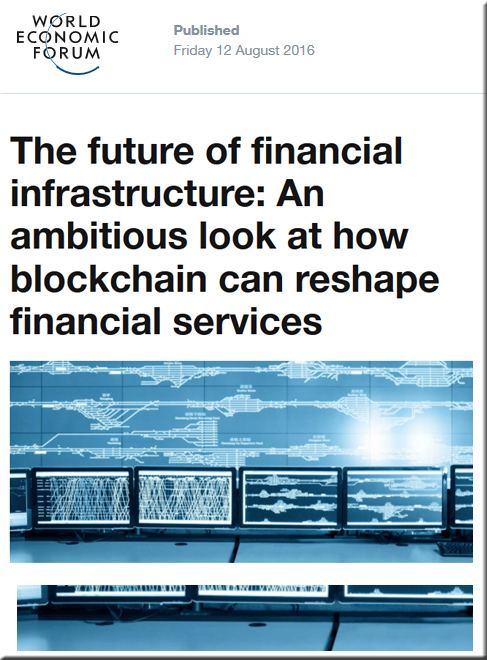The future of financial infrastructure: An ambitious look at how blockchain can reshape financial services — from weforum.org
Key findings include:
- Distributed ledger technology (blockchain) has the potential to drive simplicity and efficiency by establishing new financial services infrastructure and processes
- Distributed ledger technology will form the foundation of next generation financial services infrastructure in conjunction with other existing and emerging technologies
- Similar to technological advances in the past, new financial services infrastructure will transform and question traditional orthodoxies in today’s business models
- The most impactful distributed ledger technology applications will require deep collaboration between incumbents, innovators, and regulators, adding complexity and delaying implementation
The report is centered on use cases, considering how distributed ledger technology could benefit each scenario. How will blockchain transform the future of financial services?
Ernst & Young’s report anticipates blockchain to reach critical mass in 3-5 years — from coinspeaker.com by Tatsiana Yablonskaya
Ernst and Young explains that financial industry is far from being the only one that can benefit from the blockchain technology.
Excerpt (emphasis DSC):
Ernst & Young, leading consulting firm, one of the “Big Four” audit firms and the third largest professional services firm in the world, has made some predictions about the future of the blockchain technology and its significance in various industry sectors in the recent report.
The attention of multiple financial companies has been focused on the blockchain lately. This unique technology is well adaptable to the increasing requirements of secure bookkeeping and automation in various industries.
The EY report predicts that blockchain will reach critical mass in financial services in 3-5 years, with other industries following quickly. “One reason the blockchain reaction is racing toward critical mass faster than previous disruptive technologies is that it is arriving in the midst of the digital transformation already sweeping through most sectors of the global economy. Consequently, despite the obstacles still to be overcome, businesspeople and governments are preconditioned to recognize blockchain’s potential. Tech companies have already established much of the digital infrastructure required to realize blockchain business visions.”
From DSC:
Applying this technology towards the world of learning…
I wonder how blockchain might impact credentialing for lifelong learning, and will it be integrated into services available via tvOS-based applications? This type of cloud-based offering/service could likely be a piece of our future learning ecosystems. Innovative, forward-thinking institutions should put this on their radar now, and start working on such efforts.










![The Living [Class] Room -- by Daniel Christian -- July 2012 -- a second device used in conjunction with a Smart/Connected TV](http://danielschristian.com/learning-ecosystems/wp-content/uploads/2012/07/The-Living-Class-Room-Daniel-S-Christian-July-2012.jpg)